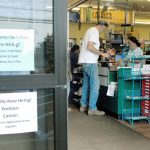Editor’s note: This is the first in a two-part series looking at Hawaii Island’s job market and unemployment rate. Today’s story looks at the need for employers to fill positions while tomorrow’s story will look at the thriving construction industry.
Hawaii County’s unemployment rate may be the highest in the state, but the numbers don’t tell the whole story.
In fact, job seekers on the island, especially in the Kona area, have the upper hand, Michelle Conrey, regional manager for job placement firm Altres, said this week.
“There are more jobs than people at the moment. … It’s as short as we’ve ever been as far as qualified employees,” said Conrey, who’s worked in the area more than 17 years. “It’s really tough for businesses right now.”
Unemployment data released by the state Department of Labor and Industrial Relations on Thursday show Hawaii County’s unemployment rate at 4.1 percent, dropping slightly from last month’s 4.2 percent. That compares to Honolulu County’s 3 percent, Maui County’s 3.4 percent and Kauai County’s 3.9 percent.
“There are different rates of unemployment in different sectors,” said Bill Kunstman, Department of Labor and Industrial Relations spokesman.
Nonagricultural jobs on the Big Island increased from 62,000 in January to 64,000 in November, he said.
Professional, scientific and technical service jobs dropped from 6,700 to 6,400 during the same time period, while service positions increased from 46,100 to 47,100.
Construction jobs are thought to be increasing the most, but Conrey is seeing a shortage of workers in a range of professions from service workers to accountants to chief financial officers to managers.
“Construction is booming again and they tend to suck up the really well-qualified workers,” Conrey said Thursday. “It’s just tough … We’re all fighting for the same people.”
Conrey said employers are offering increasing salaries to attract the best workers. Jobs are running “$1, $2, $3 more an hour,” she said. Jobs at less than $11 an hour just aren’t being snapped up, while salaries at $60,000 and more annually are becoming closer to the norm for qualified workers, she said.
“The reality is that companies face competition in the same job. You’re competing with others out there,” she said.
Increasing confidence in the economy is also pulling people out of the job market, opting instead to become their own bosses through new or expanded businesses of their own.
Hawaii County is helping that process along with the opening of two Business Resource Centers, one in the county building in Hilo and one at the West Hawaii Civic Center.
The Hilo center opened Nov. 2, the Kona center Nov. 10, and they’re proving to be very popular, said Kawehi Inaba, director of the county Department of Research and Development, which created the centers. So far, more than 120 people have come through the doors, the majority in the Kona office, she said.
The centers provide a range of services for people interested in starting their own business or expanding a current one. The one-on-one services in the center help people with bookkeeping, bidding on county contracts, grant writing, licensing, business registration, trade name registration and more. Farming, food and beauty products, bed and breakfasts and service industries are among people’s dreams for their own companies.
One happy customer is Rochelle Cushnie of Kona.
“I did use it and I was very impressed,” she said.
Cushnie’s looking to start a new company after experiencing some success with Electromed Inc., a medical billing service. The new business will concentrate on recruiting medical personnel to areas they’re needed most, she said.
“They answered my questions. They were a wealth of information and presented me with very detailed resources,” said Cushnie, who visited the Kona center Dec. 9. “I’ve made a lot of progress because of that meeting. They were very useful in kick-starting appropriate resources. They’re plugged into the community.”
Cushnie plans to return the favor.
“They’re a great resource for me. Why not help them by being a great resource for them as well,” she said.
Inaba said creating the centers has been a very rewarding experience.
“Opportunity generation. Being able to identify a specific industry — for example the food truck industry — being able to help people from A to Z on their businesses, whether they’re starting a business, expanding a business or improving a business,” she said.
“I understand that small businesses are the economic drivers, helping people gain employment, but also to empower them to start their own business. It’s bigger than helping one person. It’s helping them create something bigger that helps the whole community,” she added. “It’s helping people believe in themselves, helping people realize their potential. It’s powerful and it’s very cool.”
Altres’ Conrey said new and longtime employers need to pay attention to their workers, especially now.
Retaining current employees makes a lot more sense than hiring and training new people, if those prospective employees are even available.
If companies can’t find experienced employees, they might want to train someone who has a good attitude and is willing to learn, she said.
If a company can’t compete on wages, sometimes offering employees additional benefits, such as more vacation time, could keep them from straying.
“It’s definitely an employee’s market. … The reality is it can take you a really long time to find another person,” Conrey said. “If you have good employees, you better make sure you take care of them, because it’s really tough to replace them.”











